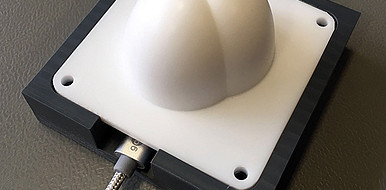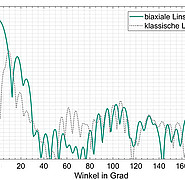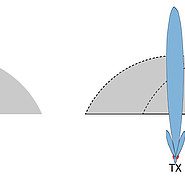Dual lens for radar antennas
With increasing technological progress, the fields of application of radar sensors become more and more diverse. A major challenge is to enhance the efficiency of sensors with separate transmit and receive antennas while retaining or increasing precision and reducing dimensions. For many applications, such as distance or filling level sensors, it is necessary to focus the radar signals in a defined direction.
State of the art
To adjust the main lobe direction, lenses are usually used to reduce the opening angle of the antennas and thus the beam width of the radar. In practice, the antennas are positioned as close as possible to each other under a common lens. Due to the slight offset of the antennas to the focal point of the lens, the radiation directions are shifted, resulting in a performance loss in the common main lobe direction.
Technology
A novel lens from the Institute of High Frequency Technology and Electronics (IHE) at KIT eliminates these disadvantages and provides an identical main lobe direction for both antennas. First, the lens geometries are constructed independently according to the antenna configurations. The configured lenses can be identical, but can also be constructed with different parameters such as diameter, focal length or shape. The designed lens geometries are then merged into each other and melted into a dual lens, whereby the separate antennas are positioned in the respective focal point of the dual lens. The dual lenses are manufactured in the same way as classic lenses by injection moulding, CNC milling or 3D printing, usually out of plastic.
Advantages
The dual lens generates a clear main radiation with improved transmission power and significantly reduced power loss due to radiation tilting. Compared to classic lenses, the antenna design is also more flexible. In addition, the new dual lens can be easily integrated into existing radar systems.
Options for companies
Different designs of the dual lens have already been tested at the Institute for high-frequency applications. KIT is looking for licensees for industrial use, especially in the automotive sector or in industrial automation.
Your contact person for this offer

Innovation Manager Mobility and Information Karlsruhe Institute of Technology (KIT)
Innovation and Relations Management (IRM) Phone: +49 721 608-28460
Email: birgit.schulze@kit.edu



